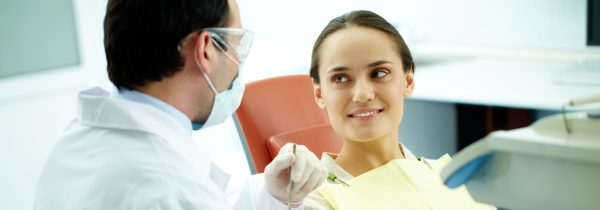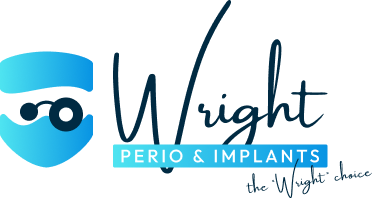Minimally Invasive Gum Disease Treatment With LANAP
At Wright Perio & Implants in San Clemente, CA, we offer a cutting-edge alternative to traditional gum surgery—LANAP—laser periodontal treatment. If you’ve been told you need surgery for periodontal disease or gum disease, but you’re worried about discomfort or a lengthy recovery, LANAP may be the perfect minimally invasive treatment for you.
LANAP, short for Laser-Assisted New Attachment Procedure, uses the PerioLase® MVP-7™ dental laser to treat periodontal disease and regenerate healthy gum and bone tissue. This laser periodontal therapy offers a minimally invasive laser treatment that eliminates diseased tissue, preserves healthy tissue, and promotes periodontal regeneration—all without cutting, sutures, or surgical glue.
To find out if LANAP is right for you, call our dentist’s office in San Clemente at (949) 361-4867 or book an appointment with a dentist’s office near you.
Why Choose Wright Perio & Implants for LANAP in San Clemente?
Led by Dr. Raymond L. Wright Jr., a board-certified periodontist with extensive training in laser-assisted new attachment procedures, Wright Perio & Implants is one of the few dental offices in San Clemente offering this advanced gum disease treatment. Dr. Wright has undergone extensive training through Millennium Dental Technologies to perform LANAP with precision, safety, and predictable results.
What sets our practice apart:
- Specialized focus on periodontal disease and gum tissue health
- Certified use of PerioLase® MVP-7™ laser technology
- Personalized treatment plans for treating periodontal disease and regenerating tissue
- Emphasis on patient education and long-term periodontal health
Wright Perio & Implants in San Clemente is proud to offer laser-assisted periodontal therapy as a safer, more comfortable treatment option for gum disease.
What Is LANAP and How Does It Work?
LANAP is an FDA-cleared laser therapy for treating periodontal disease and advanced gum disease. It targets diseased gum tissue while leaving healthy tissue intact. Unlike traditional gum surgery, which requires cutting and suturing, LANAP uses laser light to treat infected areas with precision and minimal discomfort.
Here’s how LANAP works:
- The PerioLase® MVP-7™ emits a specific wavelength of laser energy to target and eliminate diseased tissue
- The laser fiber is inserted into the periodontal pockets to remove bacteria and pathologic proteins
- Once infected tissue is cleared, ultrasonic scaler tips and root planing are used to remove tartar
- A stable fibrin blood clot forms to support new attachment and bone regeneration
- The healing process stimulates the growth of connective tissue and alveolar bone
This advanced gum disease treatment offers a modern solution for patients who want effective results with less trauma and faster healing. To learn more about gum health, call our top-rated periodontist in San Clemente at (949) 361-4867 today.
Benefits of LANAP Treatment
Choosing LANAP over conventional surgical procedures provides a wide range of benefits for patients dealing with gum disease:
- Minimally invasive: No need for cutting or stitches, preserving natural tissue
- Leaves healthy tissue intact: Focuses only on diseased tissue
- Promotes bone regeneration: Encourages growth of bone and connective tissue
- Minimal discomfort: Most patients report little to no post-operative pain
- Faster recovery: Less downtime compared to traditional periodontal surgery
- FDA-cleared: Backed by clinical research and proven safety
- Safe for patients on blood thinners: No need to stop medications
- Reduces gum recession: Tissue shrinkage is minimal
- Improves oral health and periodontal health: Supports long-term results
If you’ve been avoiding gum surgery due to fear of discomfort or recovery, LANAP is a modern laser treatment that could change your outlook on treating gum disease.
Common Signs You May Need LANAP Treatment
Gum disease symptoms can develop slowly and without obvious signs until it becomes more severe. Early detection is crucial.
Watch for these signs:
- Bleeding gums when brushing or flossing
- Swollen, tender, or inflamed gum tissue
- Persistent bad breath or a bad taste in your mouth
- Gum recession or gum line pulling away from the teeth
- Loose or shifting teeth
- Visible tartar buildup or periodontal pockets
If left untreated, gum disease can lead to tooth loss, bone loss, and damage to your connective tissue and tooth roots. Don’t wait—call our office near you at (949) 361-4867 to discuss your options for treating gum disease with laser-assisted periodontal therapy.
Comparing LANAP to Traditional Gum Surgery
LANAP treatment offers a patient-friendly alternative to traditional periodontal surgery. While conventional surgery often involves cutting, removing gum tissue, sutures, and longer healing times, LANAP offers a less traumatic, more comfortable approach.
- Traditional gum surgery:
- Requires scalpels, sutures, and removal of gum tissue
- Involves significant post-operative pain and swelling
- Can lead to gum recession and a longer recovery
- May require bone grafts to rebuild lost bone
- LANAP laser treatment:
- Minimally invasive laser fiber targets only diseased gum tissue
- Leaves healthy tissue intact and promotes tissue regeneration
- Less post-operative pain and a faster healing process
- Stimulates bone growth and reattachment to tooth roots
For most patients, LANAP offers an effective, modern way to restore periodontal health without the dental trauma of conventional surgery.

What to Expect During LANAP Treatment
At your initial consultation, Dr. Wright will evaluate your gum health, perform a full periodontal examination, and assess the depth of your periodontal pockets. Digital X-rays may also be used to evaluate alveolar bone loss and tissue damage.
The LANAP appointment typically includes:
- Administration of local anesthesia for comfort
- Insertion of the laser fiber between the gum and the tooth root to remove diseased gum tissue
- Use of ultrasonic scaler tips and root planing to clean the tooth roots
- A second pass of the laser to form a stable fibrin clot
- No sutures, no cutting, and minimal discomfort
The entire laser-assisted periodontal treatment can often be completed in one or two visits, depending on the severity of the gum disease. Most patients return to normal activity within 24 hours. Call Wright Perio & Implants in San Clemente at (949) 361-4867 to start your treatment today.
Aftercare and Long-Term Results
Following LANAP treatment, your body begins a natural healing process. The stable fibrin blood clot formed during the procedure protects the area and supports regeneration.
To support healing and maximize results:
- Follow your provider’s at-home care instructions
- Avoid brushing the treated area for several days
- Eat a soft food diet during initial healing
- Attend all follow-up appointments to monitor progress
LANAP doesn’t just treat symptoms—it promotes true periodontal regeneration. Many patients experience reduced pocket depths, improved gum attachment, and better oral health long term. Most patients also report less bleeding, healthier gums, and reduced inflammation.
Is LANAP Right for You?
LANAP may be the best laser treatment option if you:
- Have been diagnosed with moderate to advanced periodontal disease
- Prefer a minimally invasive alternative to traditional surgery
- Are taking blood thinners and cannot pause medication
- Have experienced gum recession and want to preserve gum tissue
- Desire long-term oral health improvements
Wright Perio & Implants offers laser-assisted periodontal therapy that’s tailored to your specific needs. If you’ve been searching for a periodontist near you in San Clemente who specializes in treating gum disease with laser technology, we invite you to schedule a consultation.
Call (949) 361-4867 to learn how we can help restore your periodontal health with LANAP.

Frequently Asked Questions
LANAP can often be completed in one to two visits, depending on the severity of gum disease. Each appointment may take 1 to 2 hours.
Most patients experience minimal discomfort. Local anesthesia is used during treatment, and recovery is typically quicker and less painful than traditional surgery.
Yes. LANAP is effective for treating advanced gum disease and regenerating lost bone and tissue. It’s a safe and proven laser therapy for most patients.
Yes. Since LANAP doesn’t require cutting or sutures, it’s safe for patients who cannot pause medications like blood thinners.
Call Today for Laser Periodontal Therapy in San Clemente
If you’re experiencing signs of gum disease, don’t wait. Wright Perio & Implants provides great LANAP laser periodontal treatments in San Clemente, CA. Our team is dedicated to delivering minimally invasive laser treatment that helps you avoid traditional periodontal surgery and enjoy faster healing.
Contact our office today at (949) 361-4867 to schedule a consultation and take the first step toward healthier gums, better oral health, and lasting periodontal regeneration. Your smile deserves the best—experience the benefits of LANAP at a trusted dentist’s office near you.
